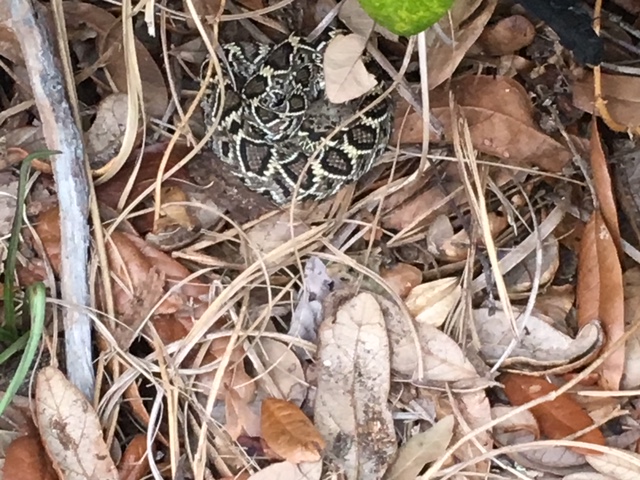
by Rick O'Connor | Mar 9, 2018
Most people know that snakes are ectothermic and the environment is what regulates their body temperature. However, many do not know that they like to maintain their temperature close to 98 F like us. To do this they must move to locations where they can either warm (like basking in the sun or lying on warm asphalt) or cool (like under rocks or logs). Unlike us, their temperature can rise to above 100 F or down close to 30 F with few health problems.
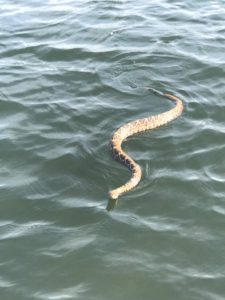
Eastern Diamondback Rattlesnake swimming across the Intracoastal Waterway near Pensacola Beach.
Photo: Andy Barnes
When environmental temperatures become colder, their heart and breathing rates slow significantly. Their blood oxygen levels decrease, and they become very slow and sluggish – a condition we call torpor. There are some advantages to this, such as not having to hunt for food for several weeks or months, but when the air temperatures begin to climb they become more active… Moreover, their hungry.
In the last two weeks, I have had numerous reports of snakes moving around in yards. There have been three records of diamondback rattlesnakes in the Pensacola Beach area alone.
Should I be concerned about doing outdoor activities?
No, not really – but you should be aware. As it warms, snakes will become more active early in the morning and late in the evening. Pit vipers, like rattlesnakes and cottonmouths, actually prefer hunting at night. However, when the temperatures are cool enough for mid-day movement, they will. Food and reproduction (for some species) are on their mind this time of year.
Stay on the trails – snakes typically do not like to be in the open because of predators but they do have to bask to increase their body metabolism; so they may be along the edge. If I am hiking, I tend to look down along the trail when walking. If I want to observe something in the trees, I stop.
These snake movements happen every year, and very people have problems, but with the recent increase in encounters it is could to be aware. I actually think snakes are pretty cool. I enjoy seeing them, especially ones that are not viewed very often like coral snakes and rattlesnakes. You should still go out and enjoy the Pensacola Bay area. It is a great time of year to do it.
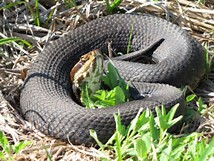
by Rick O'Connor | Aug 11, 2017
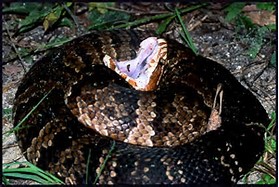
the “cottonmouth” gape of this venomous snakes is a warning. Notice the banded coloration of this individual.
Photo: UF IFAS Wildlife
Also known as the Water Moccasin, this is a snake that is all too familiar with most Floridians… Or is it? Several non-venomous water snakes are often confused with the cottonmouth and are thus killed. That said, cottonmouths are common in the state near areas of water and many residents do have encounters with them. This fact sheet will provide information that help reduce negative encounters with this venomous snake.
DESCRIPTION
- cottonmouths have a relatively thick-stout body with a broad head and thin neck
- they are generally banded and can be brown, gray, reddish in color; many become darker with age and may be solid black; cottonmouths who frequent tannic waters may have cooper color to them
- average length 36″ (3 ft.); max length 74″ (6 ft.)
JUVENILE DESCRIPTION
- copper colored with a yellowish-green tipped tail; used to attract prey
HOW TO TELL FROM NON-VENOMOUS WATER SNAKES
- there are several species of water snakes from the genus Neroidia which are confused with cottonmouths
- the scales between the eyes on top of the head are larger than others on the head; they have narrow necks
- Neroidia will have heads shaped more like your thumb and neck is as wide as head – NOTE: Neroidia CAN WIDEN THEIR HEAD WHEN THREATENED
- when head is viewed from above, the eyes of the cottonmouth are hard to see
- cottonmouths have a creamed colored cheek with dark “mask” extending from eye to back of lower jaw
- Neroidia may have creamed colored cheek but will lack “mask”; will possess thin vertical stripes that extend from lower to upper jaw
- there are single scales extending from the vent (anus) to tip of tail in cottonmouths; those same scales are divided into multiple ones on Neroidia
- the underside of the cottonmouth tail is usually dark; Neroidia is usually lighter in color
- pupil of cottonmouth is elliptical; it is round on Neroidia
- cottonmouths, being members of the pit viper family, will have heat sensing pit between nostril and eye; Neroidia will lack this pit
- scales are keeled, but this is true for some non-venomous snakes
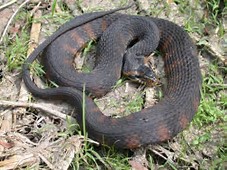
This banded water snake is often confused with the cottonmouth. This animal has the vertical stripes extending from the lower jaw, which is lacking in the cottonmouth.
Photo: University of Georgia
HOW TO TELL FROM OTHER PIT VIPERS
- cottonmouths are often confused with copperheads – both in same genus
- copperheads will lack characteristic “mask” found on cottonmouths and rattlesnakes
- the bands of the copperhead are more uniformed than the cottonmouth and are shaped like an hour glass
- copperheads are generally lighter in color
- it is difficult to tell young copperheads and cottonmouths apart; both have the light yellow-green tipped tail and light body coloring
SUBSPECIES OF COTTONMOUTHS
- there three recognized subspecies of cottonmouths
- the Florida Cottonmouth (Florida (A.p.conanti) – is darker, many times black, with two vertical bars on snout; found throughout the state of Florida
- the Eastern Cottonmouth (A. p. piscivorous) is lighter in color than the Florida and has no pattern on snout; found in extreme western Florida panhandle and the Appalachian valley of Alabama, Georgia, Tennessee, and North Carolina
- the Western Cottonmouth (A.p.leucostoma) – is similar to the eastern cottonmouth but darker in color; found in Mississippi, Louisiana, Texas, and Oklahoma
WHATS IN A NAME
- The Cottonmouth and the Water Moccasin are the two names for the same snake; herpetologist prefer to use the name Cottonmouth
- The snake was originally described by B.G.E. Lace (1789) using the term “piscivorous”; which means “fish eater”
- Gerard Troost (1836) describe the western subspecies using the term “leucostoma”; which means “white mouth”
- Howard Kay Gloyd (1969) described the Florida subspecies using the term “conanti”; which was honoring the herpetologist Roger Conant of the Philadelphia Zoo
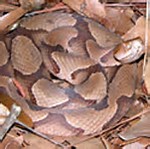
Many in the panhandle use the terms cottonmouth and copperhead interchangeably. They are closely related but this photo of a copperhead shows the lighter coloration and the hour-glass shaped pattern of the blotches along the body.
Photo: UF IFAS Wildlife
BEHAVIOR
- cottonmouths are found throughout the southeast United States but avoid mountainous areas
- they are usually found with 30 feet of a water source, though some have been found as far as 100 feet away
- they prefer slow, quiet, backwater areas over faster flowing waterways
- they are most common in pine flatwoods but can be found in a variety of habitats and do well near humans
- they have been found in brackish water areas but freshwater is usually nearby
- they are becoming more common on barrier islands, and in some cases in high numbers, but do need sources of freshwater; they cannot extract from seawater
- cottonmouths hunt primarily at night; though daylight hunting happens
- on cool mornings they may climb lower branches of trees to bask; usually close to water
- they will remain still in one location for long periods of time waiting for prey to come within range; but they are known to stalk prey as well
- when prey are found they will strike using their hollow fangs to inject a hemotoxin; this venom is known to contain components that cause death, by attacking the muscle and circulatory system, and digestive enzymes to begin the process before swallowing
- in the cooler parts of their range cottonmouths will hibernate; but tend to be active year round in FL
PREY
- cottonmouths are carnivorous and opportunistic; prey include fish, small mammals, reptiles and birds; they will feed on smaller cottonmouths
- they are known to scavenge and are attracted to the smell of dead fish
- they hunt primarily at night but are known to during daylight hours as well
- they hunt fish and CAN bite underwater – despite the legend that they cannot
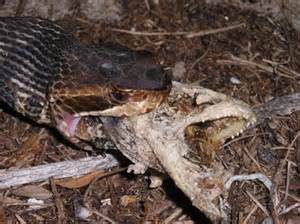
Cottonmouth’s are known to feed on a variety of prey including carrion.
Photo: University of Florida
PREDATORS
- primary predator include alligators, kingsnakes, and larger cottonmouths
- secondary predators include large mammals, birds, hawks, and owls
- cottonmouths tend to “freeze” when they first detect a predator – no movement at all
- if the predator gets too close they will vibrate their tail in leaf litter to alert the intruder and may gape their mouth showing the white inside of their “cottonmouth”; they may also flatten their bodies to appear bigger and release a musk as a warning
- they prefer to flee than bite but they will strike if they have nowhere to flee
REPRODUCTION
- mating occurs in spring and sometimes fall; in Florida they may mate year round
- males sense pheromones from females to know when it is time and, like other vipers, males may fight for the right to mate
- females can store sperm for long periods of time and typically breed every other year
- females give live birth in late summer to early fall; they sometimes congregate to give birth
- the average number of offspring/litter is 7-12 but can be as high as 22
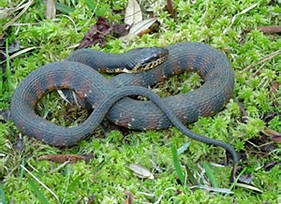
Is this a cottonmouth?
No, it is not…
Can you tell why?
Photo: University of Florida
DEALING WITH ENCOUNTERS
KEEPING THEM AT A DISTANCE
- when hiking in cottonmouth territory it is recommended to wear high boots and look down while walking; if you need to look ahead we recommend you stop walking – look ahead – and then put your eyes back to the ground while walking
- stay on trails; snakes do not like short grass; avoid walking in tall grass where they may be hiding
- to keep cottonmouths away from your home – reduce food sources, freshwater sources, and shelter areas
- cottonmouths like fish ponds and are often found in the filter system; they may be attracted to swimming pools
- cottonmouths also eat rodents; bird feeders, sacks of corn, wood and brush pikes can attract cottonmouth prey, and thus cottonmouths
- if you must have brush piles and bird feeders place them away areas where people frequent – away from front and back doors, sidewalks, etc.
- many properties have natural ponds and swimming pools; if encounters are a problem consider placing some small mesh fencing to keep them from reaching the source may be helpful; this fencing should be buried 2-6″ below the surface and the wooden stakes should be on your side of the fence – snakes can climb the rough wood stakes; if you cannot continue the fencing across your entire property – make a 90° turn AWAY from your property to encourage them to return from where they came
IF I ENCOUNTER ONE
- despite stories, cottonmouths do not chase people; most will sit very still hoping you do not see them; I have personally accidentally placed my foot within inches of a cottonmouths with no reaction from the snakes; their first reaction is to “freeze”
- if they feel you are getting too close they often will begin to vibrate their tail very fast; this means they are getting nervous and are warning you to stay clear; many times they are in leaf litter when they do this and you can hear them – DO NOT APPROACH ANY CLOSER; the probability of a strike is still low, but has increased
- another warning behavior is mouth gaping and showing of white mouth- “cottonmouth”; though strike probability is still low, studies show that gaping cottonmouths tend to strike more often than tail vibrating ones – DO NOT APPROACH; move back and allow the snake to pass

The dark phase of the cottonmouth. This is an older individual.
Photo: UF IFAS
BUT WHAT IF I ALLOW IT TO PASS AND IT IS HEADING FURTHER ON TO MY PROPERTY?
- great news right?
- statistics show that about 95% of people bitten by snakes are trying to catch it or kill it – so trying to remove it yourself significantly increases your chance of getting bit
- many have had success with sweeping non-venomous snakes into a trash can with a broom and releasing somewhere… But these are non-venomous snakes, we recommend professionals for venomous snake removal
- you may have no other optional than to kill the snake; if this is the case be careful… Again, many are bitten trying to kill snakes; also know that snakes are known to strike after they are a dead
WHAT IF I AM BITTEN?
- first know that death from cottonmouths is very rare; annually in the U.S. about 7,000 – 8,000 people are bitten by venomous snakes (about 1 in 40,000 people) and about 5-6 die (about 1 in 50 million)
- also know that many times vipers give what is called a “dry bite” – no venom injected; but you do not know this so treat as if venom was injected; MANY WHO DIE FROM VENOMOUS SNAKE BITES DID NOT SEEK MEDICAL ATTENTION
- first rule is DO NOT GET BIT TWICE; after being bit many people will then try to kill the snake and are bitten again; many feel that they need the snake at the hospital for identification – they do not
- second rule is to remain calm; easier said than done, but an elevated heart rate will move the toxin within the blood faster
- with toxic viper bites there will be pain and swelling; remove watches, jewelry, or any tight fitting clothing from bite area
- you do not need to add ice or heat
- we do not recommend tourniquets, lancing the bite and sucking out venom; many times the venom has spread from the bite area and health officials have found that many times there are more problems with the “first aid” than with the bite itself
- try not to move the limb where bite occurred- easier said than done; if you can elevate your heart above the bite this is good
- do not drink alcohol; you may think you need a drink right now but you do not; alcohol or caffeine can accelerate heart and spread venom faster
- call 911 and alert the closest hospital that you have a snake bite victim coming in; answer any questions they may have to the best of your ability
- again, do your best to relax and get to a hospital; fatalities are rare due to the excellent medical care in this country
All of this said, there is a lot of concern surrounding cottonmouths in Florida. As we expand our neighborhoods into more of their habitat, we will encounter more of them. In some cases, the location for their resources may be our neighborhoods. We will need to learn how to identify them and understand their behavior to avoid negative encounters. The statistics show that they are not as big a threat as they are perceived to be, but folks are still concerned for their family and pets – and understandably so. Hopefully information in this fact sheet will be of help to you.
REFERENCES
Ashton, R.E., P.S. Ashton. 1981. Handbook of Reptiles and Amphibians of Florida; Part I Snakes. Windward Publishing. Miami FL. pp. 175.
Gibbons, W., M. Dorcas. 2005. Snakes of the Southeast. University of Georgia Press. Athens, GA. Pp. 253.
Gibbons, W. 2017. Snakes of the Eastern U.S. University of Georgia. Athens GA. pp. 416.
http://www.bioone.org/doi/abs/10.2994/1808-9798(2008)3%5B175:TEOICS%5D2.0.CO%3B2
http://www.bioone.org/doi/abs/10.1643/CH-04-243R1?journalCode=cope
https://academic.oup.com/bioscience/article/58/10/947/245888/Pitviper-Scavenging-at-the-Intertidal-Zone-An
http://escholarship.org/uc/item/9j69w675
http://ufdc.ufl.edu/files/UFE0046057/00001/WIXSON_J.pdf
http://www.herpconbio.org/Volume_10/Issue_2/Hanson_McElroy_2015.pdf
http://onlinelibrary.wiley.com/doi/10.1111/j.1365-2699.2008.02075.x/full
http://www.bioone.org/doi/abs/10.1643/0045-8511(2002)002%5B0195:DBOCAP%5D2.0.CO%3B2
https://academic.oup.com/beheco/article/15/2/365/223992/Size-based-variation-in-antipredator-behavior
http://www.jstor.org/stable/3890390?seq=1#page_scan_tab_contents
https://www.floridamuseum.ufl.edu/herpetology/fl-snakes/list/agkistrodon-piscivorus-piscivorus/
http://ufwildlife.ifas.ufl.edu/pdfs/cottonmouth.pdf
Johnson, S.A. Frequently Asked Questions About Venomous Snakes. http://ufwildlife.ifas.ufl.edu/venomous_snake_faqs.shtml.
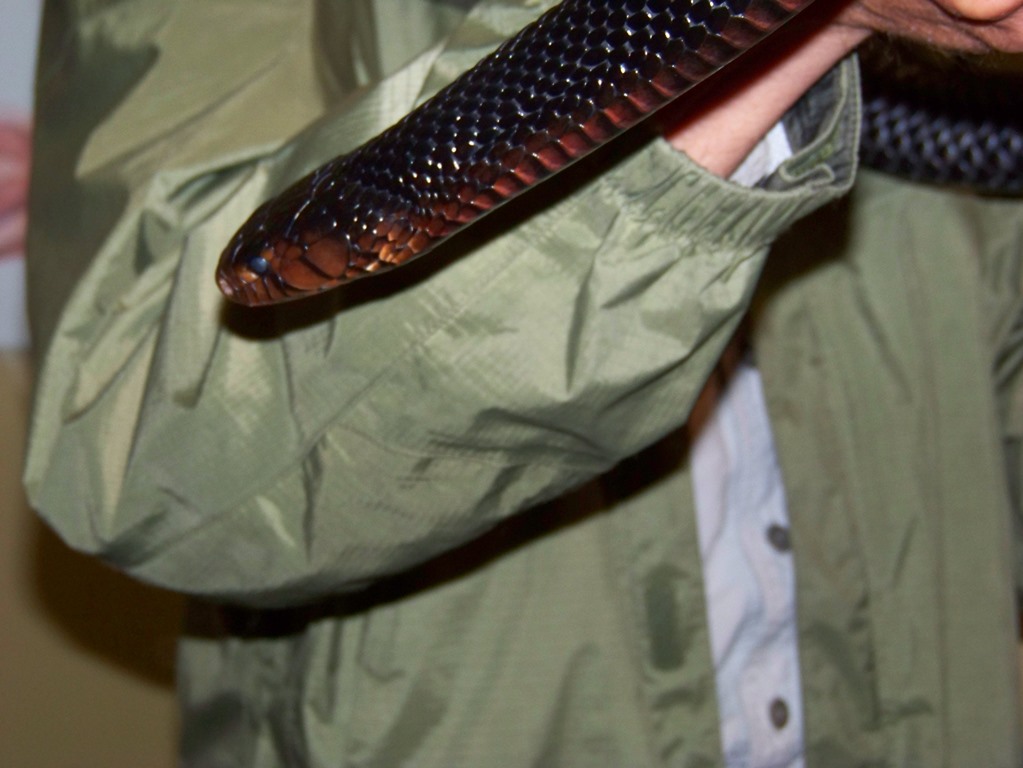
by Rick O'Connor | Aug 21, 2015
With great interest I read this week that the Orianne Center for Indigo Conservation in central Florida has begun a project to reintroduce the federally listed Eastern Indigo Snake (Drymarchon corais cooper) to the Florida Panhandle; where there have been no verified sightings since the late ‘90s.
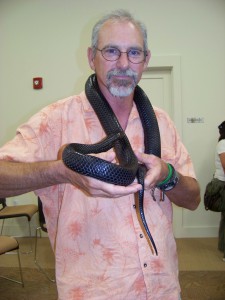
The eastern indigo snake is the largest nonvenomous snake in the southeast.
Photo: Molly O’Connor
The Eastern Indigo is the largest nonvenomous snake in the southeast, reaching lengths of eight feet. They prefer sandhills and dry upland areas such longleaf pine forest. The males can patrol areas as large as 3000 acres and are associated with gopher tortoise burrows. Being large snakes they feed on a variety of animals including venomous rattlesnakes. The loss of habitat, along with the decline of gopher tortoises, triggered the decline of this species, and they are rarely seen in the western portions of the range. Indigos are most often found in southern Georgia and peninsular Florida, but sightings at these locations are not common.
The Orianne Center is currently raising young Indigos for release in the Nature Conservancy’s Apalachicola Bluffs and Ravine Preserve. They are planning to release 20 snakes there and an additional 30 in the Conecuh National Forest to support a similar project that Auburn has been doing for the last four years. These snakes are pretty easy to identify. They are iridescent black, usually having an oily sheen appearance to them, with orange coloration on the lower jaw. Oh… and they are big… 8 feet. We are hoping panhandle residents will not be alarmed if they encounter one and allow them to move along. During the last four years of Auburn’s project they have lost quite a few to cars and one visited a youth camp in the National Forest. Alarmed at first the residents soon learned that they were feeding on copperheads in the tool shed and have since loved having these snakes around.
You can read more about this project and the Orianne Center at:
http://blog.nature.org/science/2015/08/17/indigos-return-a-florida-breeding-program-raises-eastern-indigo-snakes-for-reintroduction/
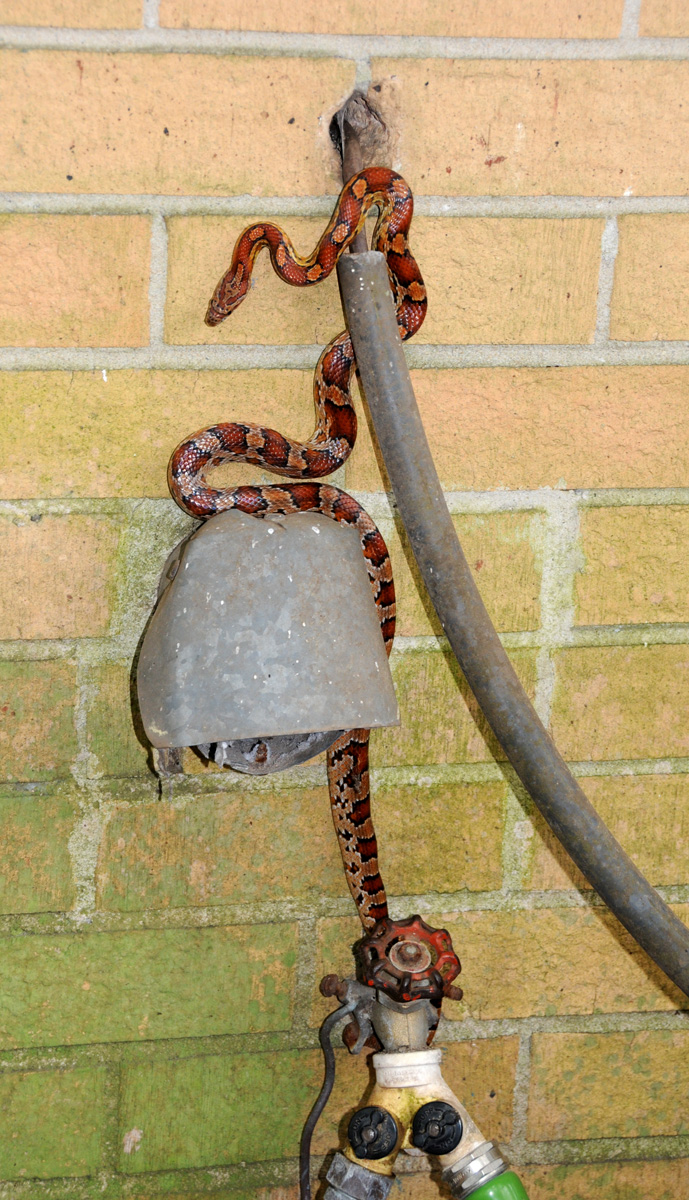
by Rick O'Connor | Aug 14, 2015
Most people, including myself, have been taught this. Snakes are in an unusual situation of trying to kill prey with no hands or claws. A few can inject venom, others either swallow it whole (such as an egg) or the coil around their prey “suffocating” it – or so we thought. It has been my understanding that snakes did not actually “squeeze” the air out of their prey but rather coil tighter each time the prey exhales, tighten the coils until the prey is dead due to lack of oxygen. A recent paper published in the Journal of Experimental Biology is challenging this.
The issue stems around the fact of how fast the prey die. Some biologists felt death of the prey occurred to quickly for suffocation; thus began the hunt of what was the cause. Dr. Scott Boback, of Dickinson College in Pennsylvania, looked at the possibility of cardiac arrest. He and his team developed a method of monitoring cardiac and circulatory data in rats before, during, and after an attack by a constricting snake; in this study – the common boa. Using pre-attack vitals as baseline the team compared numbers during the attack and after death; which occurred, on average, 6.5 minutes. What they found was interesting.
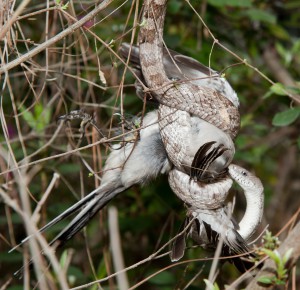
A constricting gray rat snake coils around a bird.
Photo: Nick Baldwin
Within six seconds of being bitten and having the body coil the peripheral arterial blood pressure dropped by half and the central venous blood pressure increased six fold. After 60 seconds the heart rate had dropped by 50%. After death, again mean time was 6.5 minutes, the peripheral arterial blood pressure and heart rate had dropped significantly and 91% of the rats (n=11) had evidence of a dysfunctional cardiac system. Blood samples were taken from the deceased rats. These samples indicated that the potassium levels had increased 2-fold and the pH and dropped from 7.4 to 7.0. Some suggest that the increased potassium levels may have been toxic enough to kill the rat.
Though this is only one study the results do suggest that the cause of death may be due to cardiac arrest and not the lack of oxygen. For many of us it is a point of “who cares… the rat is dead”. But for those of us in science education (teachers, park rangers, etc.) the results are of interest. We are being asked to explain how the scientific process works to students, visitors to parks, and to the general public. This is a good example of how science works. The process of experimentation finding results that do not always fit the “norm” of general understanding yet they do occur, generating more questions and more experimentation. Though this one study does not mean that suffocation is incorrect it does suggest there is another explanation and this, at least at this stage, is how we should explain such things to the public.
To view a copy of the article and abstract for this paper visit:
file:///C:/Users/roc1/Documents/Wildlife/nusiance%20species/Snakes/Living%20With%20Snakes/Snake%20constriction%20rapidly%20induces%20circulatory%20arrest%20in%20rats.html
http://jeb.biologists.org/content/218/14/2279.abstract

by Rick O'Connor | Apr 24, 2015
This rhyme has been around for decades suggesting that rain increases during the month of April. In recent years the amount we have received has caused local flooding, and most in Escambia County will remember receiving 26” of rain in 24 hours! These heavy localized rain events have certainly removed pollen from the air but they have also dropped blossoms from plants, dropped baby birds from their nests, forced fire ants to surface and move to high ground, and then there are the snakes.
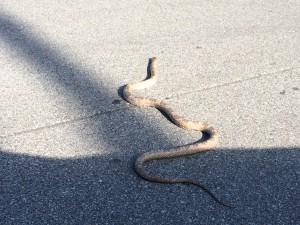
Gray rat snake crossing a driveway.
Photo: Carrie Stevenson
It was actually these flooding events that developed the need for the snake program I am currently doing for Extension. Highly saturated ground forced the snakes to search for high ground. Patios, driveways, garages, and occasionally bathrooms, became popular places for the reptiles to dry off. In the last week or two I have had calls about snakes in buses, on bushes, and in the laundry room, and I actually met someone at a restaurant to identify what kind of snake they found in their home.
For many, it does not matter what kind of snake it is, they are all terrifying and dangerous and unwanted in the yard. For others, nonvenomous snakes are not welcome but they are not life threatening. Venomous snakes on the other hand… well that’s a different story. The problem here is that many do not know how to tell a moccasin from one of the water snakes. When you are not sure, you are more nervous than you may need to be. Venomous snakes truly bother people psychologically.
There are six venomous snakes in Florida and all six have been found in the panhandle. Five of these are members of the “pit viper” group and can be identified by their triangular shaped head, elliptical pupil in the eye, and a heat sensitive pit in front of their nostril. Most venomous snakes also have a dark colored “mask” (stripe) across their face. It is the mask character that I look for first, because many nonvenomous snakes flare their head when threatened and you have to get close to check the shape of their pupil. The pit vipers include the Copperhead, Moccasin, Pygmy Rattlesnake, Timber Rattlesnake, and the Eastern Diamondback. The non-pit viper is the Eastern Coral Snake. Each of these snakes should be considered dangerous and handled only by a professional if in your home. Remember, 95% of the people bitten by venomous snakes are either trying to catch or kill them.
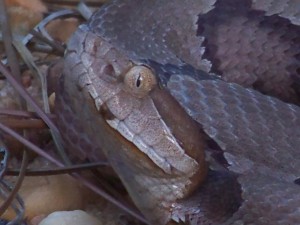
The head of a pit viper. Notice the additional pit, elliptical pupil, and “mask” across the eye. Photo: Molly O’Connor
There are several methods you can use to reduce the chance of an encounter in your yard or home, and Extension would be glad to help with these. But remember, you live in Florida and snakes are part of the landscape here. Also remember there are four snakes in the panhandle that FWC staff are tracking: the Florida Pine Snake, Southern Hognose, Eastern Indigo, and the Eastern Diamondback. If you do encounter any of these visit http://myfwc.com/conservation/you-conserve/wildlife/snakes/ to log a report and include a photograph and GPS location if possible. If you have any questions about snake encounters contact your county Extension office.















